Influence of Thermal Modification in Nitrogen Atmosphere on Physical and Technological Properties of European Wood Species with Different Structural Features
Abstract
1. Introduction
2. Materials and Methods
2.1. Wood Sampling
2.2. Thermal Modification in Nitrogen Atmosphere
2.3. Moisture Content and Wood Density
2.4. Wood Surface Finishing
2.5. Wood Photoaging
2.6. Determination of Wood Colour Parameters
2.7. Film Thickness and Cross-Cut Test
2.8. Brinell Hardness Test
2.9. Statistical Analysis
3. Results
3.1. Wood Density, the Application Rate of Agents and Film Thickness
3.2. Wood Colour and Gloss
3.2.1. Parameters Determined after Finishing
3.2.2. Parameters Determined after Photoaging
3.3. Cross−Cut Test
3.4. Brinell Hardness of Wood after Finishing
4. Conclusions
- ▪
- The process of surface finishing by varnishing and oiling poplar, oak, ash, beech and pine (native and thermally modified) was correct in the developed technology—it was effective. The effect of finishing was, among other things, a significant increase in gloss (especially after varnishing), as well as a radical change of colour (its strengthening) of all species of wood.
- ▪
- The nature of surface colour changes as a result of UV photoaging (for 100 h) was individual. In general, wood with varnish coatings was much more resistant to colour change compared to oiled wood.
- ▪
- The process of thermal modification in nitrogen significantly influenced the thickness of the varnish and oil coatings. The thermally treated wood had slightly thicker varnish coats and slightly thinner oil coats compared to the analogous ones in native wood. In the case of the thickness of the varnish coatings, the type of wood structure was also important.
- ▪
- In the case of wood with a lower density, i.e., black poplar and Scots pine, the thermal modification process in nitrogen did not reduce the resistance of the varnish coat, and in the case of a higher density of hardwood species (oak, ash, beech) there has been a decrease by one level from 1 to 2.
- ▪
- The process of thermal modification of wood with wide wood rays (oak and beech) caused the reduction of Brinell hardness in longitudinal sections. In other cases (ash, poplar, pine), the hardness did not change significantly. The applied surface finishing process by means of double varnishing or oiling did not change this property significantly.
Author Contributions
Funding
Institutional Review Board Statement
Informed Consent Statement
Data Availability Statement
Conflicts of Interest
References
- Hill, C.A.S. Wood Modification Chemical, Thermal and Other Processes; John Wiley & Sons, Ltd.: Hoboken, NJ, USA, 2006. [Google Scholar] [CrossRef]
- Bekhta, P.; Niemz, P. Effect of high temperature on the change in color, dimensional stability and mechanical properties of spruce wood. Holzforschung 2003, 57, 539–546. [Google Scholar] [CrossRef]
- Giebeler, E. Dimensional stabilisation of wood by moisture-heat-pressure-treatment. Holz Als Roh Werkst. 1983, 41, 87–94. [Google Scholar] [CrossRef]
- Militz, H.; Altgen, M. Processes and Properties of Thermally Modified Wood Manufactured in Europe In Deterioration and Protection of Sustainable Biomaterials. Am. Chem. Soc. 2014, 16, 269–285. [Google Scholar] [CrossRef]
- Ormondroyd, G.; Spear, M.; Curling, S. Modified wood: Review of efficacy and service life testing. Proc. Inst. Civ. Eng. Constr. Mater. 2015, 168, 187–203. [Google Scholar] [CrossRef]
- Esteves, B.M.; Pereira, H.M. Wood modification by heat treatment: A review. BioResources 2009, 4, 370–404. [Google Scholar] [CrossRef]
- Militz, H. Heat Treatment Technologies in Europe: Scientific Background and Technological State of Art. In Proceedings of the Conference on Enhancing the Durability of Lumber and Engineered Wood Products, Kissimmee, FL, USA, 11–13 February 2004; pp. 25–32. [Google Scholar]
- Jones, D.; Sandberg, D. A Review of Wood Modification Globally—Updated Findings from COST FP1407. Interdiscip. Perspect. Built Environ. 2020, 1, 1–31. [Google Scholar] [CrossRef]
- Barcík, Š.; Gašparík, M.; Razumov, E. Effect of temperature on the color changes of wood during thermal modification. Cellul. Chem. Technol. 2015, 49, 789–798. [Google Scholar]
- Hlásková, L.; Procházka, J.; Novák, V.; Čermák, P.; Kopecký, Z. Interaction between Thermal Modification Temperature of Spruce Wood and the Cutting and Fracture Parameters. Materials 2021, 14, 6218. [Google Scholar] [CrossRef]
- Akyurek, S.; Akman, M.; Ozalp, M. Effects of Heat Treatment on Some Chemical Compound and Mechanical Properties of Black Pine Wood. Wood Res. 2021, 66, 621–629. [Google Scholar] [CrossRef]
- Čabalová, I.; Kačík, F.; Lagaňa, R.; Výbohová, E.; Bubeníková, T.; Čaňová, I.; Ďurkovič, J. Effect of Thermal Treatment on the Chemical, Physical, and Mechanical Properties of Pedunculate Oak (Quercus robur L.) Wood. BioResources 2018, 13, 157–170. [Google Scholar] [CrossRef]
- Percin, O.; Peker, H.; Atilgan, A. The Effect of Heat Treatment on the Some Physical and Mechanical Properties of Beech (Fagus Orientalis lipsky) Wood. Wood Res. 2016, 61, 443–456. [Google Scholar]
- Kozakiewicz, P.; Drożdżek, M.; Laskowska, A.; Grześkiewicz, M.; Bytner, O.; Radomski, A.; Zawadzki, J. Effects of Thermal Modification on Selected Physical Properties of Sapwood and Heartwood of Black Poplar (Populus nigra L.). BioResources 2019, 14, 8391–8404. [Google Scholar] [CrossRef]
- Bytner, O.; Laskowska, A.; Drożdżek, M.; Kozakiewicz, P.; Zawadzki, J. Evaluation of the Dimensional Stability of Black Poplar Wood Modified Thermally in Nitrogen Atmosphere. Materials 2021, 14, 1491. [Google Scholar] [CrossRef]
- Bal, B.C.A. Comparative Study of Some of the Mechanical Properties of Pine Wood Heat Treated in Vacuum, Nitrogen, and Air Atmospheres. BioResources 2018, 13, 5504–5511. [Google Scholar] [CrossRef]
- Shukla, S.R.; Sharma, S.K. Effect of high temperature processing under different environments on physical and surface properties of rubberwood (Hevea brasiliensis). J. Indian Acad. Wood Sci. 2014, 11, 182–189. [Google Scholar] [CrossRef]
- Calonego, F.W.; Severo, E.T.D.; Furtado, E.L. Decay resistance of thermally-modified Eucalyptus grandis wood at 140 °C, 160 C, 180 °C, 200 °C and 220 °C. Bioresour. Technol. 2010, 101, 9391–9394. [Google Scholar] [CrossRef]
- Lekounougou, S.; Kocaefe, D. Effect of Thermal Modification Temperature on the Mechanical Properties, Dimensional Stability, and Biological Durability of Black Spruce (Picea mariana). Wood Mater. Sci. Eng. 2014, 9, 59–66. [Google Scholar] [CrossRef]
- Chen, Y.; Fan, Y.; Gao, J.; Stark, N.M. Effect of heat treatment on the chemical and color change of black locust (Robinia pseudoacacia) wood flour. BioResources 2012, 7, 1157–1170. [Google Scholar] [CrossRef]
- Mitsui, K.; Murata, A.; Kohara, M.; Tsuchikawa, S. Colour Modification of Wood by Light-Irradiation and Heat Treatment. In Proceedings of the First European Conference on Wood Modification, Ghent, Belgium, 3–4 April 2003. [Google Scholar]
- Candelier, K.; Dumarçay, S.; Pétrissans, A.; Gérardin, P.; Pétrissans, M. Comparison of mechanical properties of heat treated beech wood cured under nitrogen or vacuum. Polym. Degrad. Stab. 2013, 98, 1762–1765. [Google Scholar] [CrossRef]
- Jebrane, M.; Pockrandt, M.; Cuccui, I.; Allegretti, O.; Uetimane, E., Jr.; Terziev, N. Comparative study of two softwood species industrially modified by Thermowood® and thermo-vacuum proces. BioResources 2017, 13, 715–728. [Google Scholar] [CrossRef]
- Nejad, M.; Cooper, P. Exterior Wood Coatings Chapter 6 in Wood in Civil Engineering; Cocncu, B., Ed.; IntechOpen: London, UK, 2017; pp. 111–129. [Google Scholar] [CrossRef]
- Miklečić, J.; Jirouš-Rajković, V.; Pervan, S.; Grujić, S. Oils Usage in Finishing of Thermally Modifiedwood in Outdoor Applications. In Proceedings of the 21th International Scientific Conference Wood is Good—Transfer of Knowledge in Practice as a Way Out of the Crisis, Zagreb, Croatia, 15 October 2010. [Google Scholar]
- Hakkou, M.; Petrissans, M.; Bakali, E.; Gerardin, P.; Zoulalian, A. Evolution of Wood Hydrophobic Properties During Heat Treatment. In Proceedings of the First European Conference on Wood Modification, Ghent, Belgium, 1 April 2003. [Google Scholar] [CrossRef]
- Petrissans, M.; Gerardin, P.; El Bakali, I.; Serraj, M. Wettability of heat-treated wood. Holzforschung 2003, 57, 301–307. [Google Scholar] [CrossRef]
- Vital, B.R.; Oliveira, B.; Carneiro, O.; Pereira, H. Physical and Mechanical Properties of Heat Treated Wood from Aspidosperma populifolium, Dipteryx odorata and Mimosa scabrella. Maderas. Cienc. Tecnol. 2016, 18, 143–156. [Google Scholar] [CrossRef]
- Ismail, H.; Korkut, S.; Hiziroglu, S.; Sevik, H. An evaluation of properties of four heat treated wood species. Ind. Crops Prod. 2014, 60, 60–65. [Google Scholar] [CrossRef]
- Salca, E.A.; Hiziroglu, S. Evaluation of hardness and surface quality of different wood species as function of heat treatment. Mater. Des. 2014, 62, 416–423. [Google Scholar] [CrossRef]
- Priadi, T.; Hiziroglu, S. Characterization of heat treated wood species. Mater. Des. 2013, 49, 575–582. [Google Scholar] [CrossRef]
- Hill, C.A.S. Potential for the Use of Modified Woodproducts in the Built Environment. In Proceedings of the 11th International Conference on Nonconventional Materials and Technologies (NOCMAT 2009), Bath, UK, 6–9 September 2009. [Google Scholar]
- Turkoglu, T.; Kabasakal, Y.; Baysal, E.; Gunduz, A.; Kucuktuvek, M.; Bayraktar, D.K.; Peker, H. Surface Characteristics of Heated and Varnished Oriental Beech After Accelerated Weathering. Wood Res. 2017, 62, 961–972. [Google Scholar]
- Nuopponen, M.; Wikberg, H.; Vuorinen, T.; Maunu, S.L.; Jams, S.; Viitaniemi, P. Heat-treated softwood exposed to weathering. J. Appl. Polym. Sci. 2004, 91, 2128–2134. [Google Scholar] [CrossRef]
- Boonstra, M.J.; Van Acker, J.; Kegel, E.; Stevens, M. Optimisation of a two-stage heat treatment process: Durability aspects. Wood Sci. Technol. 2007, 41, 31–57. [Google Scholar] [CrossRef]
- Miklecic, J.; Jirous-Rajkovic, V. Influence of thermal modification on surface properties and chemical composition of beech wood (Fagus sylvatica L.). Drvna Ind. 2016, 67, 65–71. [Google Scholar] [CrossRef][Green Version]
- Ayata, U.; Cakicier, N. Determination of the color changes against accelerated UV aging of used water based layers on some heat-treated (ThermoWood) wood species. J. For. Fac. 2017, 17, 703–714. [Google Scholar] [CrossRef][Green Version]
- Vidholdová, Z.; Slabejová, G. Colour Stabilisation of Surface of Four Thermally Modified Woods with Saturated Water Vapour by Finishes. Polymers 2021, 13, 3373. [Google Scholar] [CrossRef]
- Çakıcıer, N.; Korkut, S.; Korkut, D.S. Varnish layer hardness, scratch resistance, and glossiness of various wood species as affected by heat treatment. BioResources 2011, 6, 1648–1658. [Google Scholar]
- Vidholdová, Z.; Slabejová, G.; Šmidriaková, M. Quality of Oil and Wax-Based Surface Finishes on Thermally Modified Oak Wood. Coatings 2021, 11, 143. [Google Scholar] [CrossRef]
- EN-13556; Round and Sawn Timber—Nomenclature of Timbers Used in Europe. European Committee for Standardization: Brussels, Belgium, 2003.
- EN 13183-3; Moisture Content of a Piece of Sawn Timber. Estimation by Capacitance Method. European Committee for Standardization: Brussels, Belgium, 2005.
- ISO 13061-2; Physical and Mechanical Properties of Wood—Test Methods for Small Clear Wood Specimens—Part 2: Determination of Density for Physical and Mechanical Tests. International Organization for Standardization: Geneva, Switzerland, 2014.
- ISO 7724-3; Paints and Varnishes—Colorimetry—Part 3: Calculation of Colour Differences. International Organization for Standardization: Geneva, Switzerland, 1984.
- ISO 2808; Paints and Varnishes—Determination of Film Thickness. International Organization for Standardization: Geneva, Switzerland, 2007.
- ISO 2409; Paints and Varnishes—Cross-Cut Test. International Organization for Standardization: Geneva, Switzerland, 2020.
- ISO 6506-1; Metallic Materials—Brinell Hardness Test—Part 1: Test Method. International Organization for Standardization: Geneva, Switzerland, 2014.
- Wagenführ, R. Holzatlas.6., Neu Bearbeitete und Erweitere Auflage. Mit Zahlreichen Abbildungen; Fachbuchverlag Leipzig im Carl Hanser Verlag: Leipzig, Germany, 2007. [Google Scholar]
- Kozakiewicz, P.; Noskowiak, A.; Pióro, P. Atlas Drewna Podłogowego [Floor Wood Atlas], 1st ed.; Proffi-Press Publishing House: Warsaw, Polnad, 2012. [Google Scholar]
- Tjeerdsma, B.; Boonstra, M.; Pizzi, A.; Tekely, P.; Militz, H. Characterisation of thermaly modified wood: Molecular reasons for wood performance improvement. Holz Als Roh Werkst. 1998, 56, 149–153. [Google Scholar] [CrossRef]
- Sivonen, H.; Maunu, S.; Sundholm, F.; Jämsä, S.; Viitaniemi, P. Magnetic resonance studies of thermally modified wood. Holzforschung 2002, 56, 648–654. [Google Scholar] [CrossRef]
- Esteves, B.; Graca, J.; Pereira, H. Extractive composition and summative chemical analysis of thermally treated eucalypt wood. Holzforschung 2008, 62, 344–351. [Google Scholar] [CrossRef]
- Olek, W.; Majka, J.; Czajkowski, Ł. Sorption isotherms of thermally modified wood. Holzforschung 2013, 67, 183–191. [Google Scholar] [CrossRef]
- Brito, A.F.; Calonego, F.W.; Bond, B.H.; Severo, E.T.D. Color changes, EMC and biological resistance of thermally modified yellow poplar. Wood Fiber Sci. 2018, 50, 439–446. [Google Scholar] [CrossRef]
- Čermák, P.; Baar, J.; Dömény, J.; Výbohová, E.; Rousek, R.; Pařil, P.; Oberle, A.; Čabalová, I.; Hess, D.; Vodák, M.; et al. Wood-water interactions of thermally modified, acetylated and melamine formaldehyde resin impregnated beech wood. Holzforschung 2022, 76, 437–450. [Google Scholar] [CrossRef]
- Wu, Z.; Deng, X.; Li, L.; Xi, X.; Tian, M.; Yu, L.; Zhang, B. Effects of Heat Treatment on Interfacial Properties of Pinus Massoniana Wood. Coatings 2021, 11, 543. [Google Scholar] [CrossRef]
- Gérardin, P.; Petrič, M.; Pétrissans, M.; Lambert, J.; Ehrhrardt, J.J. 2007: Evolution of wood surface free energy after heat treatment. Polym. Degrad. Stab. 2007, 92, 653–657. [Google Scholar] [CrossRef]
- Petrič, M.; Kričej, B.; Pavlič, M.; Kutnar, A. Surface Properties of Wood Thermally Modified in Vacuum at 210 °C. In Proceedings of the 6th European Conference on Wood Modification, Ljubljana, Slovenia, 17–18 September 2012. [Google Scholar]
- Laskowska, A.; Sobczak, J.W. Surface chemical composition and roughness as factors affecting the wettability of thermo-mechanically modified oak (Quercus robur L.). Holzforschung 2018, 72, 993–1000. [Google Scholar] [CrossRef]
- Tudorović, N.; Popović, Z.; Milić, G.; Popadić, R. Estimation of heat treated wood properties by color change. BioResources 2012, 7, 799–815. [Google Scholar]
- Gurleyen, L.; Esteves, B.; Ayata, U.; Gurleyen, T.; Cinar, H. The effects of heat treatment on color and glossiness of some commercial woods in Turkey. Drewno 2018, 61, 81–90. [Google Scholar] [CrossRef]
- Sundqvist, B.; Karlsson, O.; Westermark, U. Determination of formic-acid and acetic acid concentrations formed during hydrothermal treatment of birch wood and its relation to colour, strength and hardness. Wood Sci. Technol. 2006, 40, 549–561. [Google Scholar] [CrossRef]
- Pelit, H. The effect of different wood varnishes on surface color properties of heat treated wood materials. J. Fac. For. Istanb. Univ. 2017, 67, 262–274. [Google Scholar] [CrossRef]
- Marcon, B.; Goli, G.; Matsuo-Ueda, M.; Denaud, L.; Umemura, K.; Gril, J.; Kawai, S. Kinetic analysis of poplar wood properties by thermal modification in a conventional oven. iForests 2017, 11, 131–139. [Google Scholar] [CrossRef]
- Guller, B. Effects of heat treatment on density, dimensional stability and color of Pinus nigra wood. Afr. J. Online 2012, 11, 2204–2209. [Google Scholar] [CrossRef]
- Gurleyen, L.; Ayata, U.; Esteves, B.; Gurleyen, T.; Cakiciere, N. Effects of Thermal Modification of Oak Wood Upon Selected Properties Of Coating Systems. BioResources 2019, 14, 1838–1849. [Google Scholar] [CrossRef]
- Cividini, R.; Travan, L.; Allegretti, O. White beech: A Tricky Problem in the Drying Process Procs. In Proceedings of the International Scientific Conference on Hardwood Processing (ISCHP), Québec, QC, Canada, 24–26 September 2007; pp. 135–140. [Google Scholar]
- Allegretti, O.; Travan, L.; Cividini, R. Drying Techniques to Obtain White Beech. In Proceedings of the Improvement of Wood Drying Quality by Conventional and Advanced Drying Techniques, COST E53 Meeting and EDG Drying Seminar, Bled, Slovenia, 21–23 April 2009. [Google Scholar]
- Aytin, A.; Korkut, S.; Cakicier, N. Effect of Heat Treatment with ThermoWood Method on Some Surface Characteristic of Wild Cherry Wood, III; National Furniture Congress: Konya, Turkey, 2015; pp. 163–171. [Google Scholar]
- Korkut, D.S.; Hiziroglu, S.; Aytin, A. Effect of heat treatment on surface chracteristics of wild cherry wood. BioResources 2013, 8, 1582–1590. [Google Scholar] [CrossRef]
- Can, A. Effects of heat treatment systems on the physical properties of coated Scots pine (Pinus sylvestris L.) and poplar (Populus euramericana). BioResources 2020, 15, 2708–2720. [Google Scholar] [CrossRef]
- Demirci, Z.; Sönmez, A.; Budakçı, M. Effect of thermal ageing on the gloss and the adhesion strength of the wood varnish layers. BioResources 2013, 8, 1852–1867. [Google Scholar] [CrossRef]
- Slabejová, G.; Šmidriaková, M.; Fekiač, J. Gloss Of Transparent Coating On Beech Wood Surface. Acta Fac. Xylologiae Zvolen 2016, 58, 37–44. [Google Scholar] [CrossRef]
- Laskowska, A.; Dobrowolska, E.; Boruszewski, P. The impact of ultraviolet radiation on the colour and wettability of wood used for facades. Drewno 2016, 59, 99–111. [Google Scholar] [CrossRef]
- Laskowska, A. The influence of ultraviolet radiation on the colour of thermo-mechanically modified beech and oak wood. Maderas. Cienc. Tecnol. 2020, 22, 55–68. [Google Scholar] [CrossRef]
- Feist, W.C. Painting and Finishing Wood for Use Outdoor; Forest Product Laboratory Report: Madison, WI, USA, 1984; pp. 401–454. [Google Scholar]
- Silva, J.O.; Pastore, T.C.M. Fotodecomposição e proteção de madeiras tropicais [Photodecomposition and protection of tropicalwoods]. Floram 2004, 11, 7–13. [Google Scholar]
- George, B.; Suttie, E.; Merlin, A.; Deglise, X. Photodegradation and photostabilisation of wood—The state of the art. Polym. Degrad. Stab. 2005, 88, 268–274. [Google Scholar] [CrossRef]
- Rautkari, L.; Honkanen, J.; Hill, C.A.S.; Ridley-Ellis, D.; Hughes, M. Mechanical and physical properties of thermally modified Scots pine wood in high pressure reactor under saturated steam at 120, 150 and 180 °C. Eur. J. Wood Prod. 2014, 72, 33–41. [Google Scholar] [CrossRef]
- Sedlar, T.; Sinković, T.; Perić, I.; Jarc, A.; Stojnić, S.; Šefc, B. Hardness of thermally modified beech wood and hornbeam wood. Šumarski List 2019, 9–10, 425–433. [Google Scholar] [CrossRef]
- Kurt, S.; Özçifçi, A. Effect of various fire retardants on Brinell hardness of some wood. BioResources 2009, 4, 960–969. [Google Scholar]


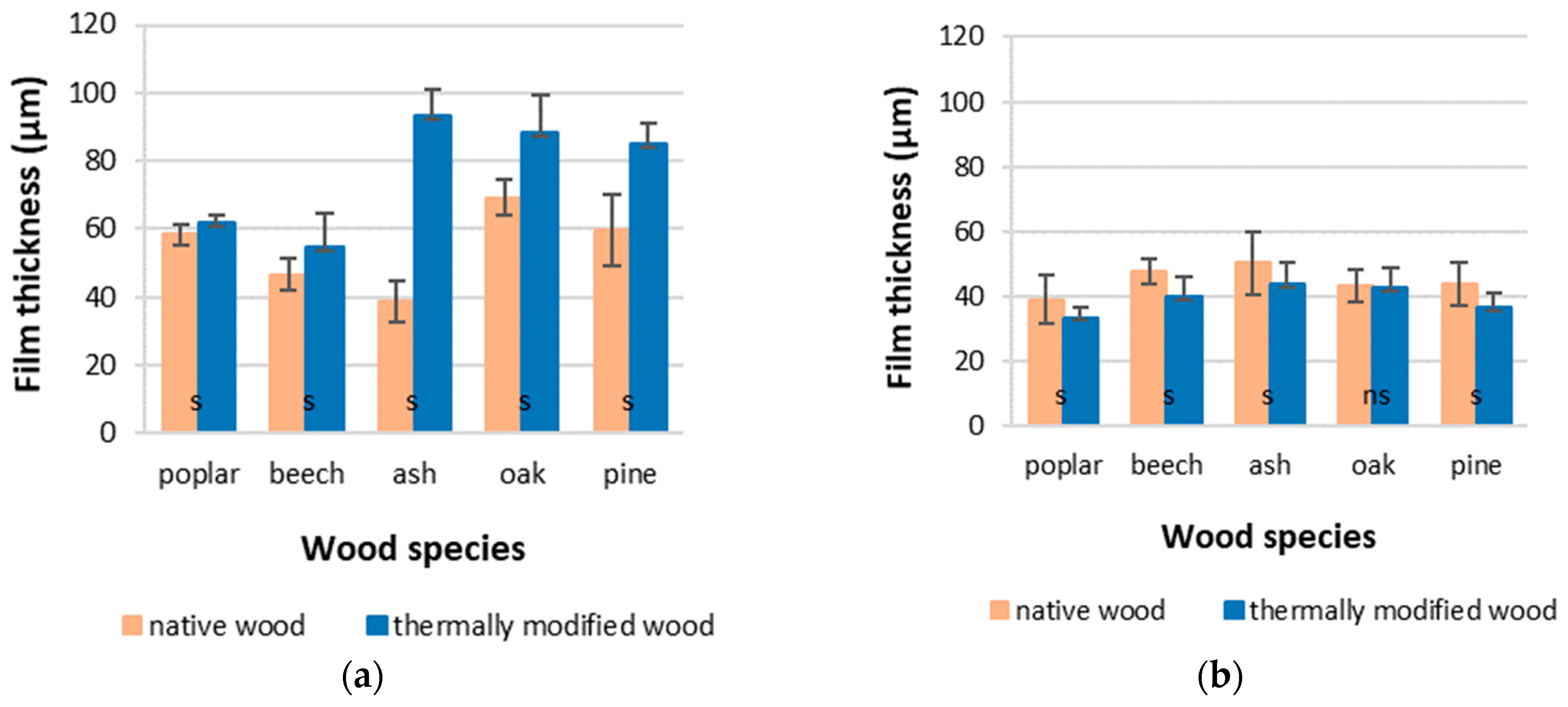
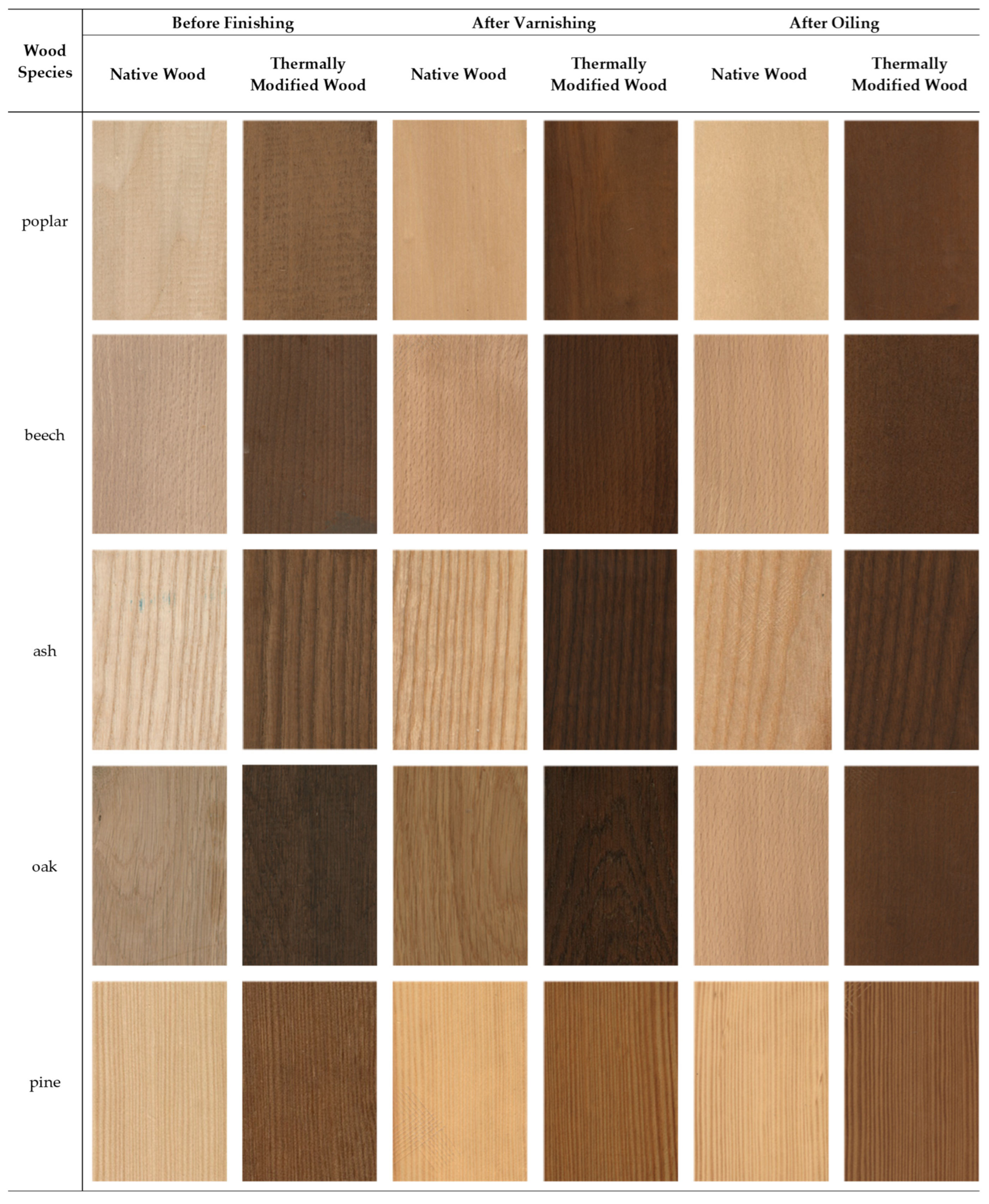
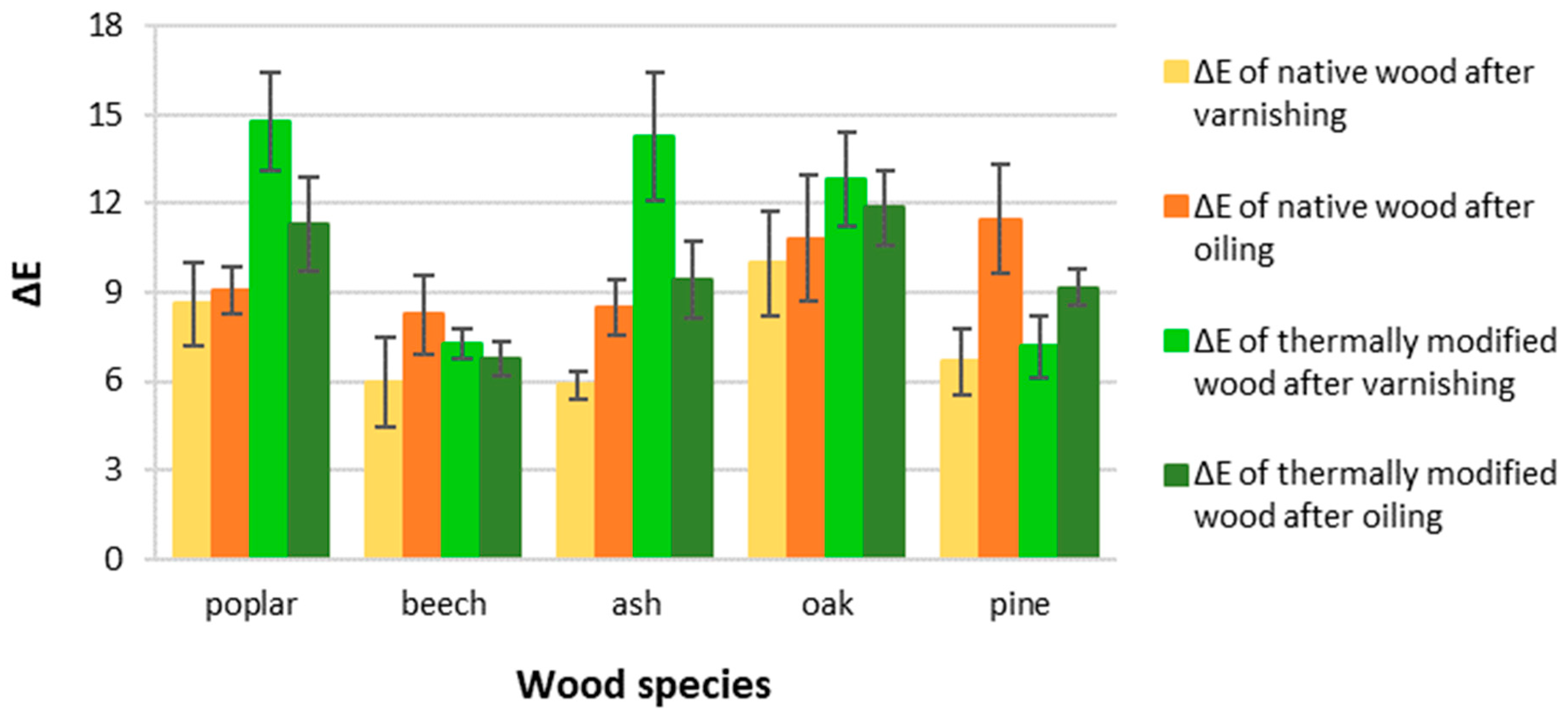
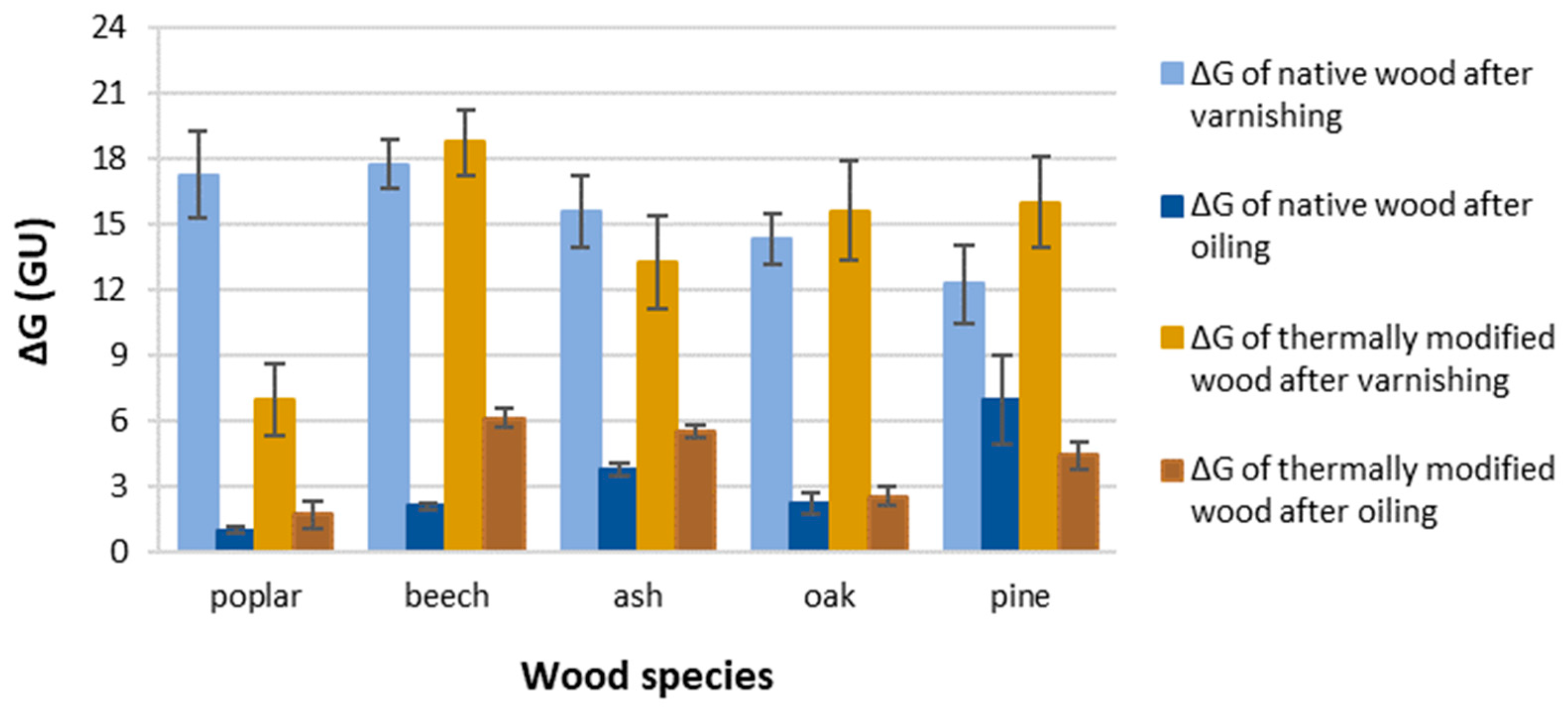
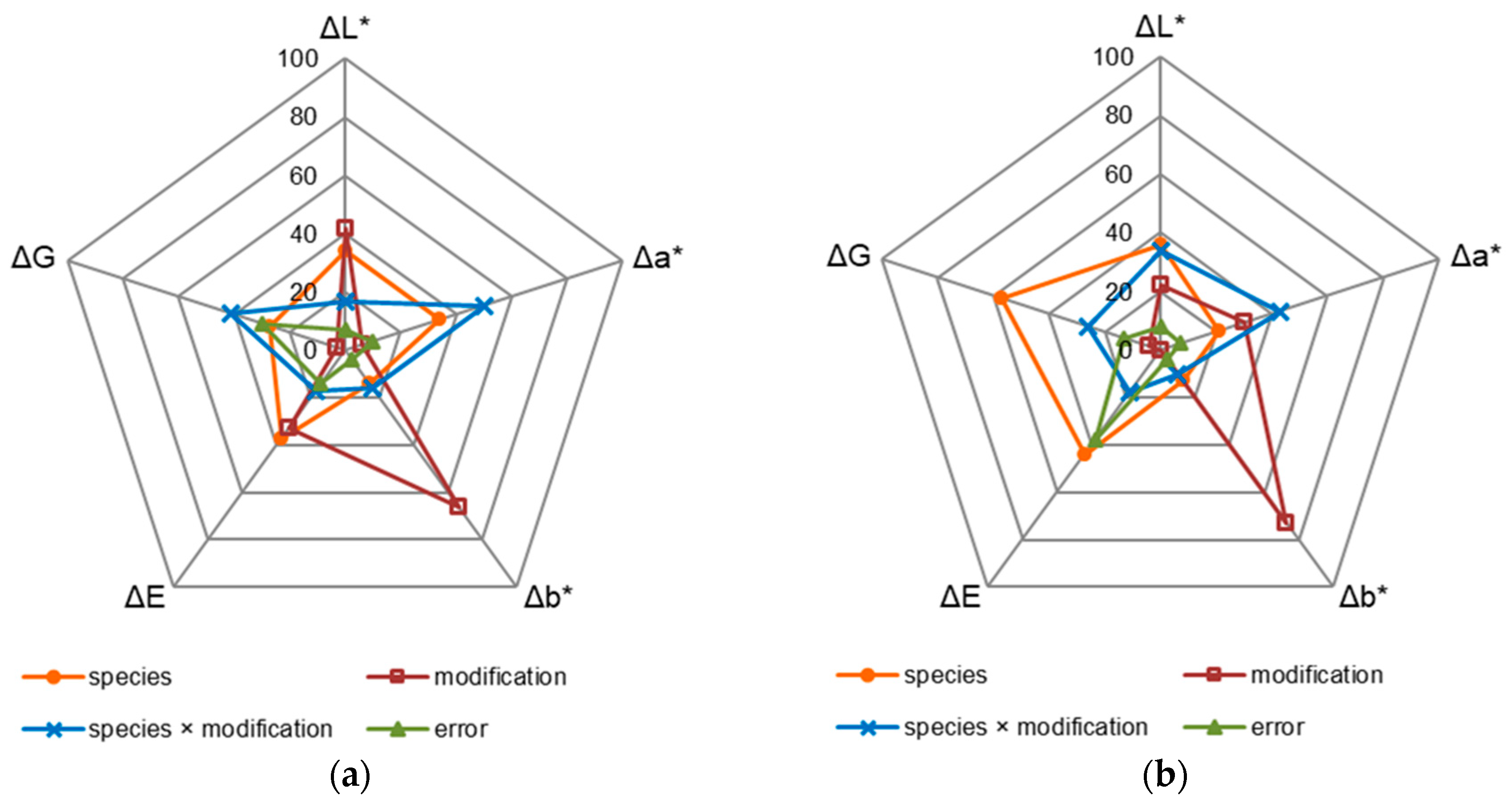
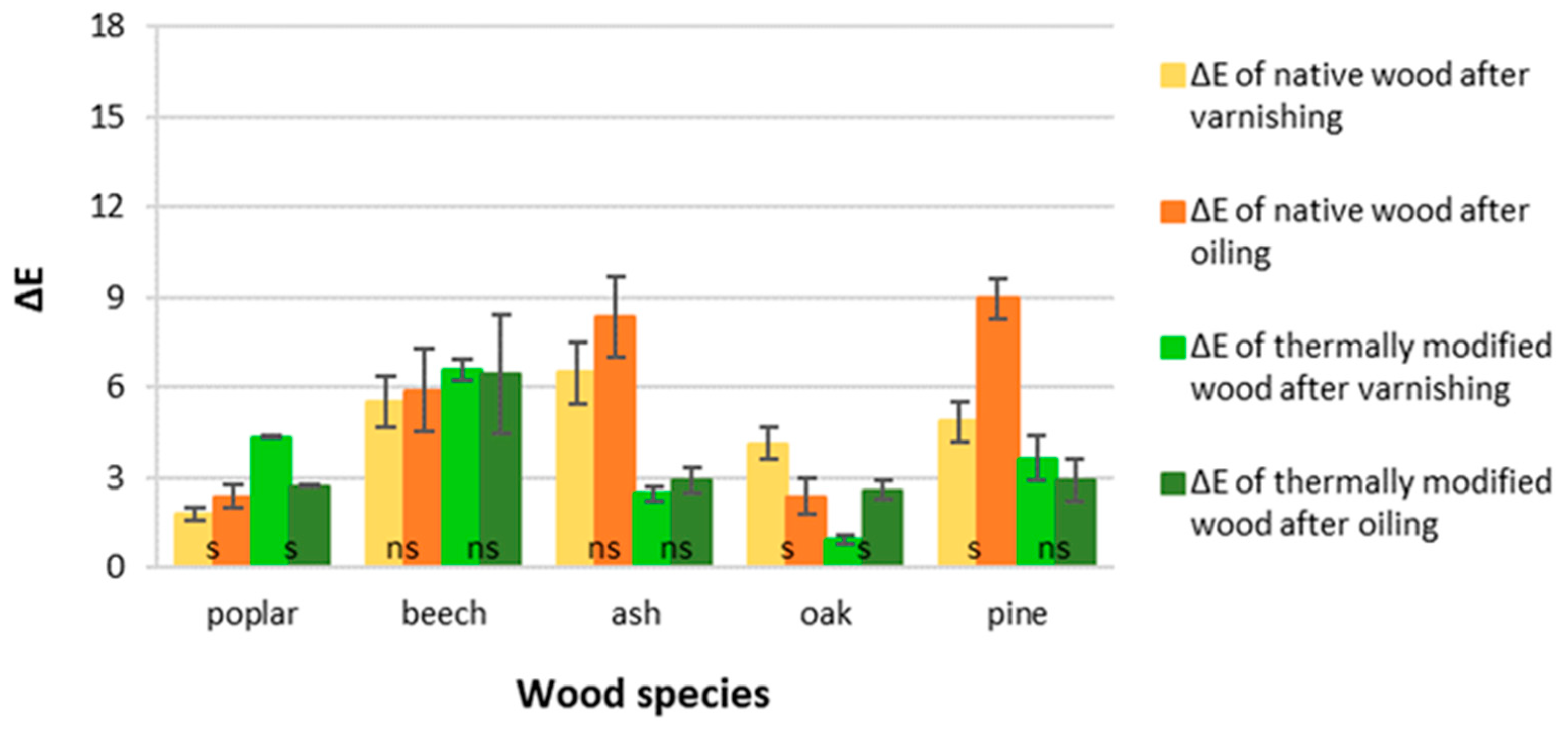
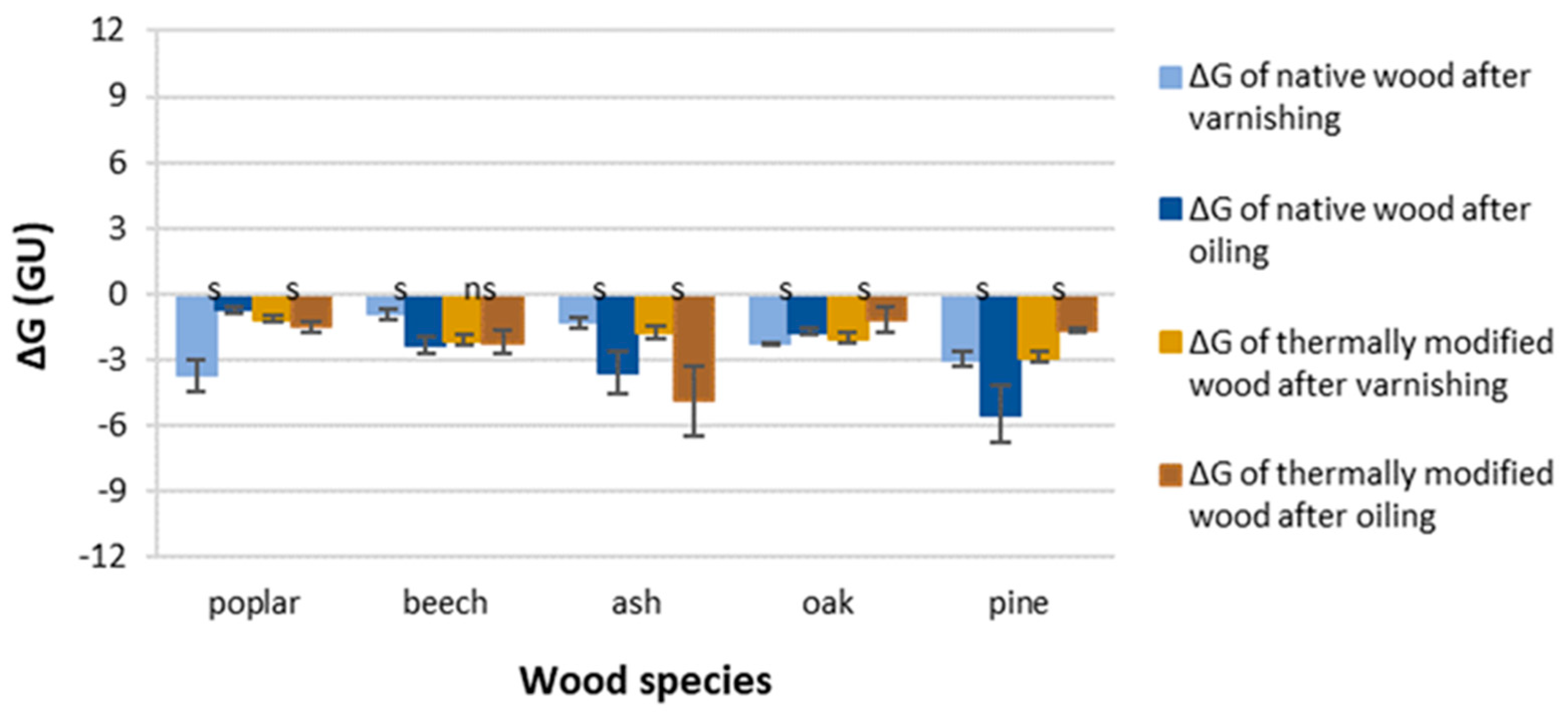
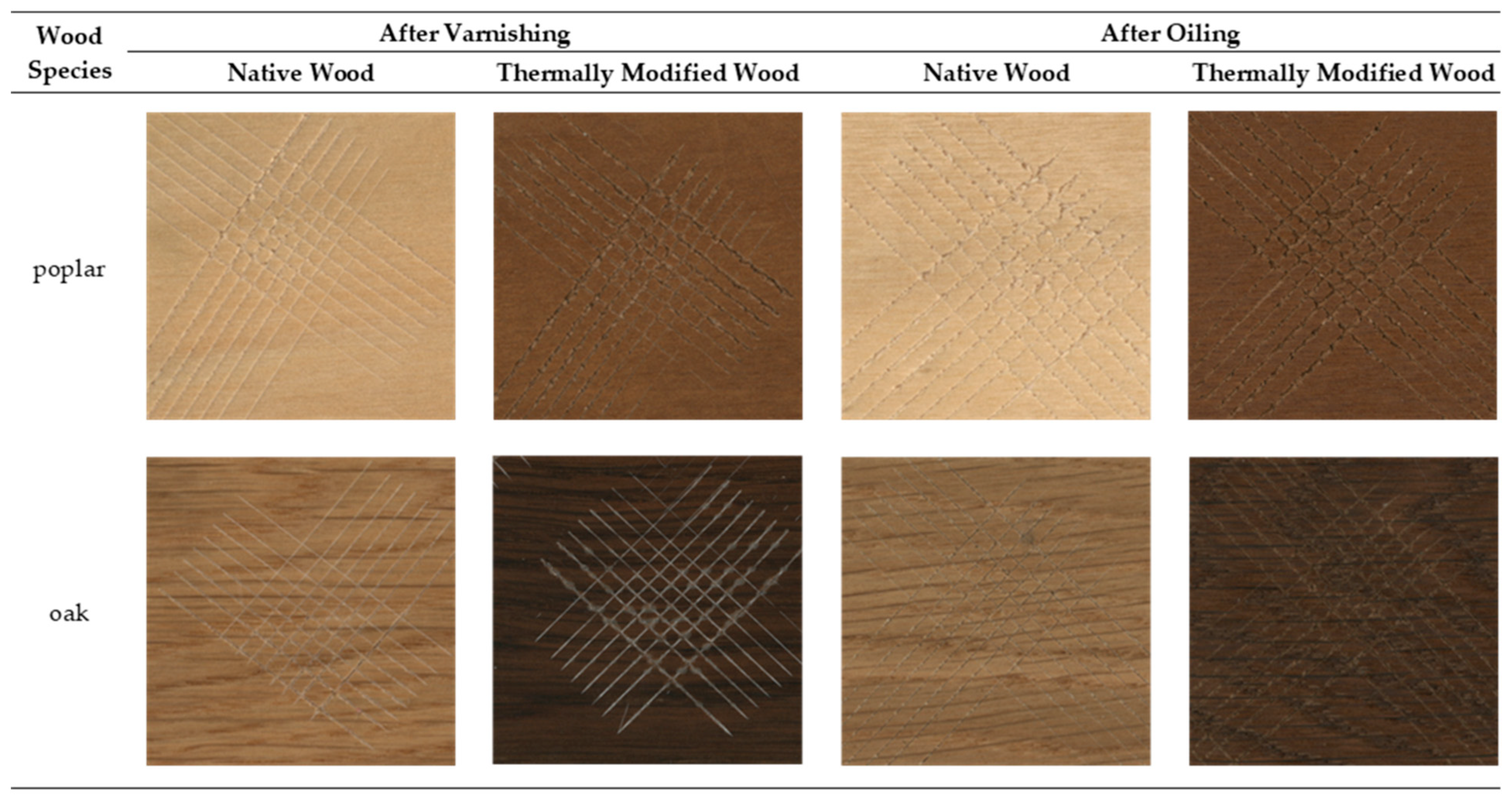
| Latin Name | Trade Name of Wood | Code According to EN-13556:2003 [41] | Wood Structure |
|---|---|---|---|
| Populus nigra L. | black poplar | PONG | deciduous diffuse-porous with fine wood rays |
| Fagus sylvatica L. | European beech | FASY | deciduous diffuse-porous with wide wood rays |
| Fraxinus excelsior L. | European ash | FXEX | deciduous ring-porous with fine wood rays |
| Quercus robur L. | European oak | QCXE | deciduous ring-porous with wide wood rays |
| Pinus sylvestris L. | Scots pine | PNS | coniferous |
| Wood Species | Wood Density (kg × m−3) | Application Rate (g × m−2) | |||
|---|---|---|---|---|---|
| Varnish | Oil | ||||
| N | TM | N | TM | ||
| poplar | 369 (5) | 111 | 128 | 16 | 17 |
| beech | 681 (20) | 102 | 112 | 16 | 19 |
| ash | 726 (14) | 122 | 146 | 16 | 18 |
| oak | 671 (3) | 105 | 132 | 18 | 20 |
| pine | 595 (7) | 118 | 129 | 18 | 20 |
| Wood Species | After Varnishing | After Oiling | ||||||||||
|---|---|---|---|---|---|---|---|---|---|---|---|---|
| ΔL* | Δa* | Δb* | ΔL* | Δa* | Δb* | |||||||
| N | TM | N | TM | N | TM | N | TM | N | TM | N | TM | |
| poplar | −3.85 | −13.29 | 1.71 | 3.14 | 7.49 | −5.51 | −2.41 | −10.26 | 0.70 | 4.39 | 8.68 | −2.81 |
| (0.75) | (1.31) | (0.54) | (0.35) | (1.15) | (1.53) | (0.44) | (2.02) | (0.13) | (0.80) | (0.83) | (0.69) | |
| beech | −1.53 | −5.70 | 0.60 | 3.66 | 5.73 | −2.36 | −3.22 | −5.15 | 1.12 | 4.35 | 7.49 | −0.34 |
| (0.54) | (0.73) | (0.21) | (0.48) | (1.55) | (1.03) | (0.57) | (0.57) | (0.29) | (0.40) | (1.40) | (0.09) | |
| ash | −2.19 | −9.93 | 1.05 | 0.24 | 5.22 | −10.17 | −5.50 | −8.21 | 0.71 | 2.48 | 6.31 | −3.85 |
| (0.24) | (1.52) | (0.17) | (0.08) | (1.48) | (1.69) | (1.08) | (1.64) | (0.18) | (0.56) | (1.45) | (0.09) | |
| oak | −8.11 | −10.32 | 3.16 | 0.67 | 4.68 | −7.56 | −9.13 | −10.26 | 3.09 | 0.87 | 4.75 | −5.89 |
| (2.09) | (1.03) | (0.49) | (0.16) | (0.68) | (1.40) | (2.58) | (1.10) | (0.29) | (0.21) | (0.26) | (0.70) | |
| pine | −3.67 | −5.02 | 2.06 | 4.59 | 4.77 | 3.46 | −9.06 | −6.84 | 2.53 | 4.95 | 6.46 | 3.45 |
| (0.97) | (1.52) | (0.55) | (0.49) | (1.14) | (1.11) | (2.18) | (0.73) | (0.69) | (0.46) | (0.29) | (0.65) | |
| Wood Species/ Variants | Poplar | Beech | Ash | Oak | Pine | |||||||||||||||||
|---|---|---|---|---|---|---|---|---|---|---|---|---|---|---|---|---|---|---|---|---|---|---|
| N_V | TM_V | N_O | TM_O | N_V | TM_V | N_O | TM_O | N_V | TM_V | N_O | TM_O | N_V | TM_V | N_O | TM_O | N_V | TM_V | N_O | TM_O | |||
| Poplar | N_V | s | s | s | ns | ns | s | s | ns | s | s | s | ns | ns | s | s | s | ns | s | s | ΔG | |
| TM_V | s | s | s | s | s | s | ns | s | s | s | ns | s | s | s | s | s | s | ns | s | |||
| N_O | ns | s | ns | s | s | s | s | s | s | s | s | s | s | s | s | s | s | s | s | |||
| TM_O | s | s | s | s | s | ns | s | s | s | s | s | s | s | ns | ns | s | s | s | s | |||
| Beech | N_V | s | s | s | s | ns | s | s | s | s | s | s | s | ns | s | s | s | ns | s | s | ||
| TM_V | ns | s | s | s | ns | s | s | s | s | s | s | s | ns | s | s | s | ns | s | s | |||
| N_O | ns | s | ns | s | s | ns | s | s | s | s | s | s | s | ns | s | s | s | s | s | |||
| TM_O | s | s | s | s | ns | ns | s | s | s | s | s | s | s | s | s | s | s | ns | s | |||
| Ash | N_V | s | s | s | s | ns | s | s | s | ns | s | s | ns | ns | s | s | s | ns | s | s | ||
| TM_V | s | ns | s | s | s | s | s | s | s | s | s | ns | ns | s | s | ns | ns | s | s | |||
| N_O | ns | s | ns | s | s | s | ns | s | s | s | s | s | s | s | s | s | s | s | ns | |||
| TM_O | ns | s | ns | ns | s | s | ns | s | s | s | ns | s | s | s | s | s | s | ns | s | |||
| Oak | N_V | ns | s | ns | ns | s | s | ns | s | s | s | ns | ns | ns | s | s | s | ns | s | s | ||
| TM_V | s | ns | s | ns | s | s | s | s | s | ns | s | s | s | s | s | ns | ns | s | s | |||
| N_O | ns | s | ns | ns | s | s | s | s | s | s | s | ns | ns | ns | ns | s | s | s | s | |||
| TM_O | s | s | s | ns | s | s | s | s | s | s | s | s | ns | ns | ns | s | s | s | s | |||
| Pine | N_V | s | s | s | s | ns | ns | ns | ns | ns | s | s | s | s | s | s | s | s | s | s | ||
| TM_V | ns | s | s | s | ns | ns | ns | ns | s | s | s | s | s | s | s | s | ns | s | s | |||
| N_O | s | s | s | ns | s | s | s | s | s | s | s | ns | ns | ns | ns | ns | s | s | s | |||
| TM_O | ns | s | ns | s | s | s | ns | s | s | s | ns | ns | ns | s | ns | s | s | s | s | |||
| ΔE | ||||||||||||||||||||||
| Factor | Parameters | |||||
|---|---|---|---|---|---|---|
| ΔL* | Δa* | |||||
| Fisher’s F-Test | Significance Level | Influence of Factors (%) | Fisher’s F-Test | Significance Level | Influence of Factors (%) | |
| F | p | X | F | p | X | |
| Species (1) | 80.776 | 0.000000 | 25 | 77.993 | 0.000000 | 25 |
| Modification (2) | 382.073 | 0.000000 | 29 | 200.965 | 0.000000 | 16 |
| Coatings (3) | 3.586 | 0.061155 | 0 | 23.538 | 0.000005 | 2 |
| (1) × (2) | 76.936 | 0.000000 | 24 | 129.119 | 0.000000 | 42 |
| (1) × (3) | 33.897 | 0.000000 | 10 | 3.353 | 0.012782 | 1 |
| (2) × (3) | 1.066 | 0.304275 | 0 | 33.768 | 0.000000 | 3 |
| (1) × (2) × (3) | 11.912 | 0.000000 | 4 | 10.346 | 0.000000 | 3 |
| Error | - | - | 8 | - | - | 8 |
| Δb* | ΔE | |||||
| Factor | Fisher’s F-Test | Significance Level | Influence of Factors (%) | Fisher’s F-Test | Significance Level | Influence of Factors (%) |
| F | p | X | F | p | X | |
| Species (1) | 87.156 | 0.000000 | 13 | 38.566 | 0.000000 | 30 |
| Modification (2) | 1816.623 | 0.000000 | 67 | 65.444 | 0.000000 | 13 |
| Coatings (3) | 62.018 | 0.000000 | 2 | 1.166 | 0.282874 | 0 |
| (1) × (2) | 83.387 | 0.000000 | 12 | 18.724 | 0.000000 | 15 |
| (1) × (3) | 5.692 | 0.000361 | 1 | 10.824 | 0.000000 | 8 |
| (2) × (3) | 6.933 | 0.009804 | 0 | 60.356 | 0.000000 | 12 |
| (1) × (2) × (3) | 6.716 | 0.000079 | 1 | 3.731 | 0.007143 | 3 |
| Error | - | - | 4 | - | - | 19 |
| ΔG | ||||||
| Factor | Fisher’s F-Test | Significance Level | Influence of Factors (%) | |||
| F | p | X | ||||
| Species (1) | 22.148 | 0.000000 | 5 | |||
| Modification (2) | 0.618 | 0.433661 | 0 | |||
| Coatings (3) | 1259.817 | 0.000000 | 76 | |||
| (1) × (2) | 15.301 | 0.000000 | 4 | |||
| (1) × (3) | 10.395 | 0.000000 | 3 | |||
| (2) × (3) | 12.121 | 0.000741 | 1 | |||
| (1) × (2) × (3) | 20.759 | 0.000000 | 5 | |||
| Error | - | - | 6 | |||
| Wood Species | Varnish | Oil | ||||||||||
|---|---|---|---|---|---|---|---|---|---|---|---|---|
| ΔL* | Δa* | Δb* | ΔL* | Δa* | Δb* | |||||||
| N | TM | N | TM | N | TM | N | TM | N | TM | N | TM | |
| poplar | −1.42 | 3.99 | 0.98 | −0.35 | 0.38 | 1.71 | −1.89 | −0.70 | 1.41 | −0.21 | 0.39 | −2.63 |
| (0.36) | (0.02) | (0.18) | (0.10) | (0.11) | (0.05) | (0.25) | (0.05) | (0.30) | (0.06) | (0.09) | (0.02) | |
| beech | −4.61 | −3.28 | 2.38 | −2.27 | 1.82 | −5.19 | −5.24 | −3.39 | 2.07 | −1.67 | 1.61 | −5.25 |
| (0.69) | (0.70) | (0.53) | (0.08) | (0.38) | (0.24) | (1.51) | (1.02) | (0.23) | (0.48) | (0.44) | (1.24) | |
| ash | −5.52 | −1.31 | 2.56 | 1.19 | 2.24 | 1.73 | −7.37 | −1.62 | 2.85 | −0.89 | 2.74 | −1.66 |
| (0.76) | (0.26) | (0.52) | (0.15) | (0.64) | (0.19) | (1.16) | (0.02) | (0.10) | (0.01) | (0.91) | (0.25) | |
| oak | −2.97 | 0.43 | 1.27 | 0.38 | 1.77 | −0.75 | 1.76 | 1.89 | 0.51 | 1.28 | 1.51 | 1.22 |
| (0.70) | (0.12) | (0.18) | (0.10) | (0.38) | (0.07) | (0.49) | (0.21) | (0.02) | (0.28) | (0.35) | (0.24) | |
| pine | −2.50 | −2.07 | 2.53 | 0.31 | 3.28 | −2.99 | 8.72 | 0.35 | −1.91 | 0.28 | 0.73 | −2.90 |
| (0.08) | (0.46) | (0.02) | (0.07) | (0.93) | (0.60) | (0.67) | (0.02) | (0.07) | (0.04) | (0.15) | (0.73) | |
| Wood Species | Cross−Cut Test | |||
|---|---|---|---|---|
| After Varnishing | After Oiling | |||
| N | TM | N | TM | |
| poplar | 2 | 2 | 2 | 3 |
| beech | 1 | 2 | 1 | 2 |
| ash | 1 | 2 | 1 | 2 |
| oak | 1 | 2 | 1 | 2 |
| pine | 2 | 2 | 2 | 2 |
| Wood Species | Brinell Hardness (N × mm−2) | |||||
|---|---|---|---|---|---|---|
| Before Finishing | After Varnishing | After Oiling | ||||
| N | TM | N | TM | N | TM | |
| poplar | 30.2 (2.6) | 30.3 (2.2) | 33.3 (3.3) s | 36.4 (2.8) s | 31,3 (2,8) ns | 31,0 (2,6) ns |
| beech | 44.8 (3.4) | 39.9 (1.8) | 45.3 (3.1) ns | 37.3 (2.3) s | 38,8 (3,7) s | 38,8 (3,8) ns |
| ash | 42.6 (6.8) | 43.0 (5.3) | 49.6 (6.3) s | 42.3 (7.4) ns | 52,9 (7,4) s | 42,6 (8,3) ns |
| oak | 44.5 (3.8) | 39.2 (2.9) | 40.4 (6.7) ns | 39.0 (5.1) ns | 43,3 (5,7) ns | 46,0 (3,2) s |
| pine | 40.7 (4.7) | 37.0 (3.9) | 39.2 (2.6) ns | 37.1 (4.3) ns | 35,6 (4,3) s | 36,7 (4,4) ns |
Publisher’s Note: MDPI stays neutral with regard to jurisdictional claims in published maps and institutional affiliations. |
© 2022 by the authors. Licensee MDPI, Basel, Switzerland. This article is an open access article distributed under the terms and conditions of the Creative Commons Attribution (CC BY) license (https://creativecommons.org/licenses/by/4.0/).
Share and Cite
Kozakiewicz, P.; Laskowska, A.; Drożdżek, M.; Zawadzki, J. Influence of Thermal Modification in Nitrogen Atmosphere on Physical and Technological Properties of European Wood Species with Different Structural Features. Coatings 2022, 12, 1663. https://doi.org/10.3390/coatings12111663
Kozakiewicz P, Laskowska A, Drożdżek M, Zawadzki J. Influence of Thermal Modification in Nitrogen Atmosphere on Physical and Technological Properties of European Wood Species with Different Structural Features. Coatings. 2022; 12(11):1663. https://doi.org/10.3390/coatings12111663
Chicago/Turabian StyleKozakiewicz, Paweł, Agnieszka Laskowska, Michał Drożdżek, and Janusz Zawadzki. 2022. "Influence of Thermal Modification in Nitrogen Atmosphere on Physical and Technological Properties of European Wood Species with Different Structural Features" Coatings 12, no. 11: 1663. https://doi.org/10.3390/coatings12111663
APA StyleKozakiewicz, P., Laskowska, A., Drożdżek, M., & Zawadzki, J. (2022). Influence of Thermal Modification in Nitrogen Atmosphere on Physical and Technological Properties of European Wood Species with Different Structural Features. Coatings, 12(11), 1663. https://doi.org/10.3390/coatings12111663








